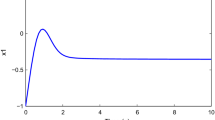Abstract
Properties and approximation algorithms for inclusion-optimal sets of practical stability are presented. Their correlation is shown for some kinds of dynamic systems. Stability time estimation is analysed for a finite interval.
Similar content being viewed by others
REFERENCES
N. G. Chetaev, “Stability of motion,” in: Works on Analytical Mechanics [in Russian], Izd. AN SSSR, Moscow (1962).
B. N. Bublik, F. G. Garashchenko, and N. F. Kirichenko, Structural-Parametric Optimization and Stability of Bundle Dynamics [in Russian], Naukova Dumka, Kiev (1985).
V. I. Zubov, Stability of Motion [in Russian], Vysshaya Shk., Moscow (1973).
G. V. Kamenkov, “On the stability of motion on a finite time interval,” Prikl. Mat. Mekh., 17, Issue 5, 529-540 (1953).
K. A. Karacharov and A. G. Pilyutik, Introduction to the Technical Theory of Stability of Motion [in Russian], Fizmatizdat, Moscow (1962).
N. F. Kirichenko, Introduction to the Theory of Stabilization of Motion [in Russian], Vyshcha Shkola, Kiev (1978).
A. A. Martynyuk, Practical Stability of Motion [in Russian], Naukova Dumka, Kiev (1983).
A. N. Lyapunov, General Problem on Stability of Motion [in Russian], Gostekhizdat, Moscow (1950).
F. G. Garashchenko and N. F. Kirichenko, “A study of problems on practical stability and stabilization of motion,” Izv. AN SSSR, No. 6, 15-24 (1975).
K. S. Matviichuk, “On technical stability of controlled dynamic processes,” Prikl. Mekh., 33, No. 9, 90-96 (1997).
F. G. Garashchenko and L. A. Pantalienko, Analysis and Estimation of Parametric Systems [in Ukrainian], ISDO, Kiev (1995).
F. G. Garashchenko, A. N. Bashnyakov, and Yu. M. Korolenko, “On practical stability of parameter-depending distributed processes,” Kibern. Vych. Tekhn., Issue 126, 81-85 (2000).
F. G. Garashchenko and L. A. Pantalienko, “A study of problems of practical stability and sensitivity of dynamic variable-structure systems,” Avtomatika, No. 2, 3-8 (1993).
F. G. Garashchenko and A. N. Bashnyakov, “PatConvergence analysis of iterative procedures based on the methods of practical stability,” Probl. Upravl. Inform., No. 2, 15-25 (1999).
F. G. Garashchenko and I. A. Kutsenko, “Practical stability of discrete processes, estimates, and their optimization,” Probl. Upravl. Inform., No. 5, 50-61 (1997).
B. N. Bublik and F. G. Garashchenko, Optimization of Structures of Linear Resonance Accelerators [in Russian], Preprint, 83.7, AN USSR, Inst. Matem., Kiev (1983).
F. G. Garashchenko, “Analysis of problems of practical stability by numerical methods and optimization of bundle dynamics,” Prikl. Mat. Mekh., 51, No. 5, 717-723 (1987).
F. G. Garashchenko, Yu. I. Totskii, I. I. Matvienko, et al., Simulation of Bundle Dynamics in Electrostatic Accelerators [in Ukrainian], Preprint, 94-18, KIYaD, Kiev (1994).
O. M. Bashnyakov, F. G. Garashchenko, and V. V. Pichkur, Practical Stability and Structural Optimization of Dynamic Systems [in Ukrainian], Kyiv Univ., Kiev (2000).
F. G. Garashchenko, A. N. Bashnyakov, and V. V. Pichkur, “Nondifferentiable optimal control problems for matrix differential equations,” Kibern. Sist. Analiz, No. 5, 92-101 (1998).
F. G. Garashchenko and M. V. Osipchuk, “On some minimax problems of matrix parametric optimization,” Probl. Upravl. Inform., No. 3, 50-60 (1995).
F. G. Garashchenko and V. V. Pichkur, “Optimal control of a matrix differential equation using Bellman method,” Probl. Upravl. Inform., No. 4, 5-17 (2000).
F. G. Garashchenko and V. V. Pichkur, “Estimates of optimal sets of initial data in a structural form,” Probl. Upravl. Inform., No. 2, 50-61 (2001).
B. N. Pshenichnyi and E. I. Nenakhov, “Matrix mathematical programming problems,” Kibern. Sist. Analiz, 2, 120-131 (1996).
F. G. Garashchenko, Directional stability, construction of optimal Lyapunov functions and sets of stability," Avtomatika, No. 5, 39-42 (1986).
F. G. Garashchenko and I. V. Strashnov, “Numerical construction of extremal sets of stability,” Vych. Prikl. Matem., Issue 52, 118-124 (1983).
F. G. Garashchenko, A. N. Bashnyakov, and V. V. Pichkur, “On necessary and sufficient conditions of practical stability,” in: Proc. Intern. Conf. “Dynamical systems modeling and stability investigation. Systems investigation” (May 25-29, 1999), Kiev Univ., Kiev (1999).
F. G. Garashchenko and V. V. Pichkur, “Optimal sets of practical stability,” Probl. Upravl. Inform., No. 5, 5-18 (1998).
F. G. Garashchenko and V. V. Pichkur, “Numerical methods of constructing optimal sets of practical stability of dynamic systems,” in: Computer Mathematics. Optimization of Calculations (Collection of Papers) [in Ukrainian], Vol. 2, Inst. Cybern., NAS Ukr., Scientific Council on Cybernetics, Kiev (2001), pp. 85-94.
V. V. Pichkur, “Weak practical stability and semistability of dynamic systems,” Kibern. Vych. Tekhn., Issue 124, 8-13 (1999).
Author information
Authors and Affiliations
Rights and permissions
About this article
Cite this article
Garashchenko, F.G., Pichkur, V.V. Analysis of Optimal Properties of Practical Stability of Dynamic Systems. Cybernetics and Systems Analysis 38, 703–715 (2002). https://doi.org/10.1023/A:1021834825050
Issue Date:
DOI: https://doi.org/10.1023/A:1021834825050



